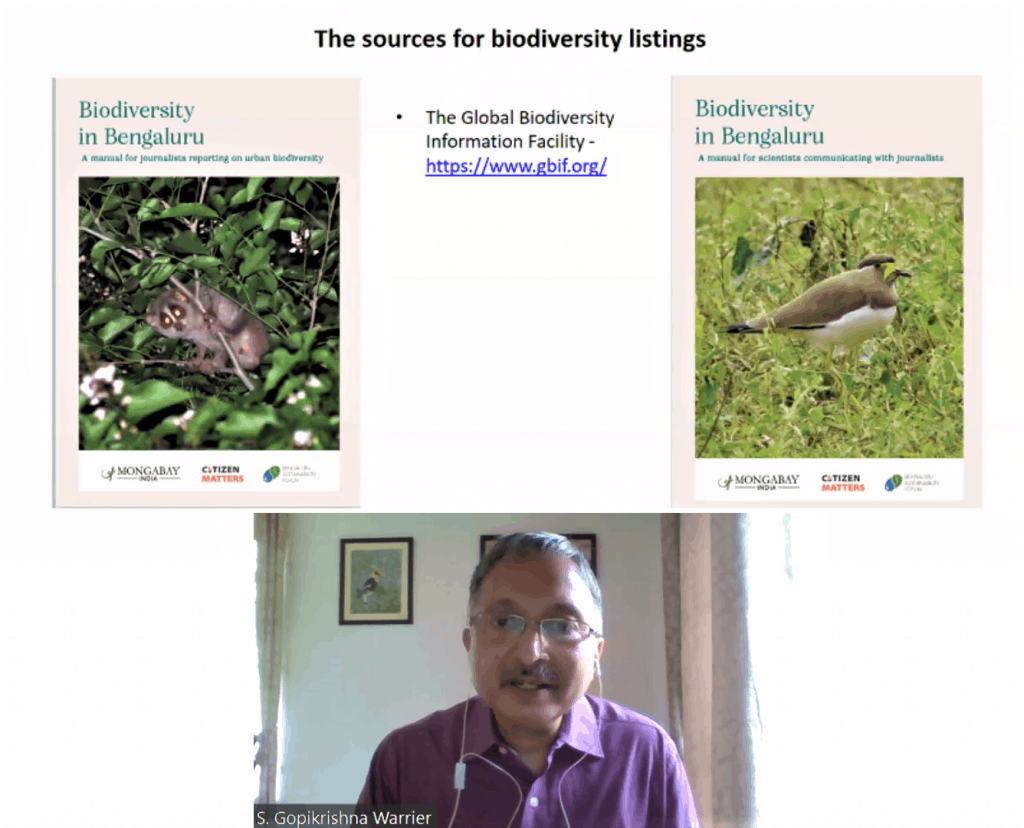Bengaluru Biodiversity Charche, organised on Saturday, September 18th, was a day-long celebration of the biodiversity of the garden city. It brought together thinkers, activists, journalists and students to explore questions surrounding urban biodiversity, threats faced by various species and how these issues could be brought to light.
The event is a culmination of the work Citizen Matters did on the topic over the past year, in collaboration with the environment and conservation magazine Mongabay-India, supported by grants from the Bengaluru Sustainability Forum.
Read more: Local residents suffer as Bengaluru lakes no longer offer food, livelihoods
Veteran environmentalists spoke
Veteran environmental activist Bittu Sahgal delivered the keynote address at the event, to an audience of school students. Bittu is the founder of Sanctuary Nature Foundation, a non-profit conservation organisation that works on environmental policy, advocacy and habitat management.
He spoke of the clock running out for older generations as they leave the environment in the care of the young. He urged youngsters to take active interest in the issues surrounding the environment, and to voice their concerns and push for change. Despite the alarm bells ringing around climate change, he expressed hope that the future would remain bright with youth leading the charge to protect the environment.
He was joined by Usha Ramaiah, who was the first Karnataka woman to scale a Himalayan peak, at the age of 22. She is a founder-member of the Karnataka Mountaineering Association. Usha shared the same concerns around the degradation of the environment, adding that little had been done to remedy the impacts. She also struck a note of hope, reiterating Bittu’s message that change is possible with committed youngsters sharing their vision for the future.
Interactive session between students and journalists
In another session, a panel of prominent environment journalists interacted with school students who had participated in the ‘Biodiversity in my Bengaluru backyard’ contest. (Citizen Matters had organised the contest in partnership with Mongabay-India and the apartment management software platform ADDA.) Journalists Mohit Rao, Apekshita Varshney, Bhanu Sridharan and Deepa Mohan shared their experiences. The session was moderated by Vasanthi Hariprakash.
Each journalist spoke of the challenges associated with reporting on urban biodiversity. They highlighted some of the stories they reported for the joint biodiversity project of Citizen Matters and Mongabay-India, and detailed the process behind the reportage. Their coverage had included stories on the loss of native food crops in Bengaluru, threats posed to the beloved Slender Loris due to urbanisation, and the murky and incomplete information supplied by large construction projects to obtain environment clearances in the city.
The journalists spoke of the importance of continuing to highlight the issues that impact the environment and biodiversity even if these stories may not receive as many views as political or crime stories. They said the subject has a deep, material impact on the lives and livelihoods of many citizens, especially those from marginalised communities.
Read more: Biodiversity loss from mega real estate projects: What is missing, what can be done?
Best entries announced
At the event, the top entries for the ‘Biodiversity in My Bengaluru Backyard’ contest was announced. Students of class 9-12 had participated in the contest by submitting reports and photographs of various plants, animals, birds and insects in their surroundings.
Best entries
Category 1 – Article
Diya Agrawal, Grade 10, National Public School
Anirudh Gopinath, Grade 9, Legacy School Bangalore
Pranav Naresh, Grade 11, The Valley School
Rakshan Pandian, Grade 10, Inventure Academy
Tarini Kumar, Grade 11, The Valley School
Category 2 – Instagram
Rohan Jacob, Grade 11, Canadian International School
Shradha Suman, Grade 12, Silicon Valley PU College
Aarushi Mahesh, Grade 9, The International School of Bangalore
Surya Turaga, Grade 11, Inventure Academy
Anvita Trivedi, Grade 10, Prakriya Green Wisdom School
The event also saw the launch of an illustrated A-Z guide, chronicling the various components of Bengaluru lakes. The illustrations cover the species and the ecosystems of the lakes, and the threats faced by them. The complete feature has been published in Citizen Matters and Mongabay India.
Webinar on biodiversity reporting
At the event, S Gopikrishna Warrier, Managing Editor at Mongabay-India, held a session for journalists on why and how to report on urban biodiversity.
He released two manuals:
- One, for journalists reporting on urban biodiversity
- Another, for scientists communicating with journalists on the topic

Gopikrishna said that threats to urban biodiversity have accelerated in recent years due to the rapid growth of cities, the resultant concretisation of spaces, and the loss of water bodies and other ecosystems that sustained various flora and fauna.
The roots of this growth could be traced back to the opening up of the Indian economy with the push for liberalisation and privatisation, back in 1991. This had a domino effect on the metro and tier 2 and 3 cities of the country, with industries growing in the outskirts and satellite towns emerging around these areas, Gopikrishna said. The session shed light on why the reporting on biodiversity conversation must not be limited to threats to endangered species or to prominent issues affecting small pockets in metros. Watch the full video of the webinar here.